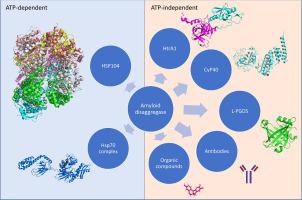Journal of Advanced Research ( IF 11.4 ) Pub Date : 2021-05-20 , DOI: 10.1016/j.jare.2021.05.007 Kimberly Jia Yi Low 1 , Anandalakshmi Venkatraman 2 , Jodhbir S Mehta 2, 3, 4 , Konstantin Pervushin 1

|
Introduction
Protein aggregation and deposition of uniformly arranged amyloid fibrils in the form of plaques or amorphous aggregates is characteristic of amyloid diseases. The accumulation and deposition of proteins result in toxicity and cause deleterious effects on affected individuals known as amyloidosis. There are about fifty different proteins and peptides involved in amyloidosis including neurodegenerative diseases and diseases affecting vital organs. Despite the strenuous effort to find a suitable treatment option for these amyloid disorders, very few compounds had made it to unsuccessful clinical trials. It has become a compelling challenge to understand and manage amyloidosis with the increased life expectancy and ageing population.
Objective
While most of the currently available literature and knowledge base focus on the amyloid inhibitory mechanism as a treatment option, it is equally important to organize and understand amyloid disaggregation strategies. Disaggregation strategies are important and crucial as they are present innately functional in many living systems and dissolution of preformed amyloids may provide a direct benefit in many pathological conditions. In this review, we have compiled the known amyloid disaggregation mechanism, interactions, and possibilities of using disaggregases as a treatment option for amyloidosis.
Methods
We have provided the structural details using protein-ligand docking models to visualize the interaction between these disaggregases with amyloid fibrils and their respective proposed amyloid disaggregation mechanisms.
Results
After reviewing and comparing the different amyloid disaggregase systems and their proposed mechanisms, we presented two different hypotheses for ATP independent disaggregases using L-PGDS as a model.
Conclusion
Finally, we have highlighted the importance of understanding the underlying disaggregation mechanisms used by these chaperones and organic compounds before the implementation of these disaggregases as a potential treatment option for amyloidosis.
中文翻译:

淀粉样蛋白解聚的分子机制
介绍
蛋白质聚集和以斑块或无定形聚集体形式均匀排列的淀粉样蛋白原纤维的沉积是淀粉样蛋白疾病的特征。蛋白质的积累和沉积会导致毒性并对受影响的个体造成有害影响,称为淀粉样变性。淀粉样变性涉及大约五十种不同的蛋白质和肽,包括神经退行性疾病和影响重要器官的疾病。尽管为这些淀粉样蛋白疾病寻找合适的治疗选择付出了艰苦的努力,但很少有化合物能够通过不成功的临床试验。随着预期寿命的延长和人口的老龄化,了解和管理淀粉样变性已成为一项引人注目的挑战。
客观的
虽然目前可用的大多数文献和知识库都将淀粉样蛋白抑制机制作为一种治疗选择,但组织和理解淀粉样蛋白分解策略同样重要。分解策略很重要且至关重要,因为它们在许多生命系统中具有先天功能,并且预先形成的淀粉样蛋白的溶解可能在许多病理条件下提供直接益处。在这篇综述中,我们汇总了已知的淀粉样蛋白解聚机制、相互作用以及使用解聚酶作为淀粉样变性治疗选择的可能性。
方法
我们使用蛋白质-配体对接模型提供了结构细节,以可视化这些解聚酶与淀粉样蛋白原纤维之间的相互作用及其各自提出的淀粉样蛋白解聚机制。
结果
在回顾和比较了不同的淀粉样蛋白解聚酶系统及其提出的机制之后,我们提出了使用 L-PGDS 作为模型的 ATP 独立解聚酶的两种不同假设。
结论
最后,我们强调了在实施这些分解酶作为淀粉样变性的潜在治疗选择之前了解这些伴侣和有机化合物使用的潜在分解机制的重要性。











































 京公网安备 11010802027423号
京公网安备 11010802027423号